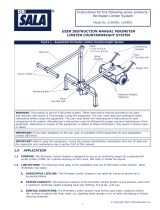Page is loading ...

1
3833 SALA Way
Red Wing, MN 55066-5005
Toll Free: (800) 328-6146 • Phone: (651) 388-8282
Fax: (651) 388-5065 • www.protecta.com
User Instruction Manual AK020A1 PROTECTA Pulley
This manual is intended to meet the Manufacturer’s Instructions as required by
ANSI Z359.1-1992 and should be used as part of an employee training program as required by
OSHA.
© Copyright 2005, PROTECTA
IMPORTANT: If you have questions on the use, care, application, or suitability of this
equipment contact PROTECTA.
1.0 APPLICATIONS
1.1 PURPOSE: The AK020A1 PROTECTA Pulley is intended to be used in combination
with the AK105A Rollgliss tripod for connection of a personal fall arrest, work
positioning, personnel riding, or rescue system. See Figure 1.
1.2 LIMITATIONS: The following application limitations must be considered before using
this product:
A. ANCHORAGE: This pulley is intended to be installed for use with a tripod, and
the anchorage must meet the strength requirements stated in section 2.1.
B. CAPACITY: This pulley is designed for use by persons with a combined weight (person, clothing, tools) of 310
lbs. for a personal fall arrest system or 350 lbs. for a work positioning, restraint, or rescue system. This
equipment allows only one user attached to the system at any time.
C. FREE FALL: Personal fall arrest systems (PFAS) must be rigged to limit the free fall to six feet or less (see
ANSI Z359.1-1992). See subsystem manufacturer’s instructions for more information.
2.0 SYSTEM REQUIREMENTS
2.1 ANCHORAGE STRENGTH: The anchorage to which this equipment is mounted must meet the following
requirements:
A. FALL ARREST: Anchorages used for personal fall arrest systems must sustain static loads, applied in the
directions allowed by the PFAS, of at least; 3,600 lbs. (16 kN) with certification of a qualified person, or 5,000
lbs (22.2 kN) without certification. See ANSI Z359.1-1992 for certification definition. When more than one PFAS
is attached to an anchorage the strengths stated above must be multiplied by the number of PFAS attached to
the anchorage.
From OSHA 1926.500 and 1910.66: Anchorages used for attachment of personal fall arrest systems shall be
independent of any anchorage being used to support or suspend platforms, and capable of supporting at least
5,000 lbs. per user attached, or be designed, installed, and used as part of a complete PFAS which maintains a
safety factor of at least two, and is under the supervision of a qualified person.
B. WORK POSITIONING: Anchorages used for work positioning applications must sustain static loads of at least
5,000 lbs. applied in the directions allowed by the work positioning system.
Figure 1 - AK020A1 Pulley
Instructions for the following
series products:
AK020A1 Pulley

2
C. PERSONNEL RIDING AND RESCUE: Anchorages used for personnel riding and rescue applications must
sustain static loads of at least 2,500 lbs. applied in the directions allowed by the personnel riding system.
WARNING: Pulleys used for rescue or personnel riding applications only must be labeled as such to prevent use as a fall
arrest or work positioning system, which require greater anchorage strengths.
3.0 OPERATION AND USE
3.1 INSTALLATION REQUIREMENTS: Secure the pulley to the tripod with included carabiner through the eyelette
attached to the center of the top bracket on the tripod. Make sure the carabiner gate is completely closed and
locked.
4.0 INSPECTION
4.1 FREQUENCY:
• Before each use inspect the pulley according to steps listed in sections 4.2 and 4.3.
• The pulley must be inspected by a competent person other than the user at least annually. See sections 4.2 and
4.3.
IMPORTANT: Extreme working conditions (harsh environments, prolonged use, etc.) may require increasing the
frequency of inspections.
IMPORTANT: If the pulley was subjected to the forces of a fall arrest, remove from service and inspect according to
sections 4.2 and 4.3.
4.2 INSPECTION STEPS:
Step 1. Inspect pulley for damage and corrosion. Check for cracks, bends, or wear that could affect the strength
and operation of this equipment. Ensure pulley turns freely, and axel is present and undamaged.
Step 2. Inspect carabiner for damage and corrosion. Check for cracks, bends, or wear that could affect the
strength and operation of this equipment. Check that gate closes and locks automatically.
4.3 If inspection reveals an unsafe or defective condition remove unit from service and destroy or contact an
authorized service center for repair.
5.0 MAINTENANCE, SERVICING, STORAGE
5.1 Clean this equipment with water and a mild detergent solution. Excessive build-up of dirt, paint, etc. may prevent
the pulley from working properly. If you have questions about the condition of this equipment, or are in doubt about
putting this equipment into service, contact PROTECTA.
5.2 Additional maintenance and servicing procedures must
be completed by an authorized service center.
5.3 Store associated subsystem components according to
manufacturer’s instructions.
6.0 SPECIFICATIONS
6.1 Material: High strength aluminum alloy
Finish: Anodized gold finish
Weight: 1.2 lbs. (with carabiner)
Capacity: 310 lbs. (one person), fall arrest 350 lbs. (one
person), personnel riding, work positioning, and rescue.
Strength: 10,000 lbs.
Form: 5902237
Rev: C
Pulley Dimensions
/
